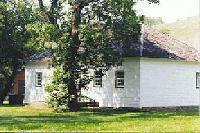© G.R. Clare, 1998
Wherever the climate was suitable and the chief trader interested, small kitchen gardens became an important source of food for the trading posts scattered across the north. The forts in the Athabaska District, in which the Peace River lay, were no exception. In fact, conditions along the Peace River were very well suited to agriculture, especially on the river flats where the forts were usually built. You just have to accidentally sit on one of our local cactus plants (Opuntia fragilis) to realize that the south-facing slopes of the Peace River valley have a unique micro-climate. Further down the slope, on the level flats above the river, nearly ideal conditions for agriculture exist. Many of these river flats were important enough in the early days to have names we still use today: Taylor, Baldonnel, Bear and Dunvegan for example.
Dunvegan was an important trading post for the NorthWest Company and later for the Hudson Bay  Company. Daniel Harmon spent a couple of winters at Fort Dunvegan and was impressed with the quantity and quality of produce which came from the fort’s gardens. In 1808, Harmon remarked that the fort had “a tolerably good kitchen garden.” Other than potatoes, Harmon doesn’t say what was grown, but it’s logical to assume that it would mostly be vegetables easily stored — turnips, parsnips, onion, carrots and cabbage would certainly be included in the list.
Company. Daniel Harmon spent a couple of winters at Fort Dunvegan and was impressed with the quantity and quality of produce which came from the fort’s gardens. In 1808, Harmon remarked that the fort had “a tolerably good kitchen garden.” Other than potatoes, Harmon doesn’t say what was grown, but it’s logical to assume that it would mostly be vegetables easily stored — turnips, parsnips, onion, carrots and cabbage would certainly be included in the list.
Harmon’s journal for May 6, 1809 reports that “we have planted our potatoes, and sowed most of our garden seeds.” By early June most of the seeds had sprouted and there was also the prospect of an abundance of wild fruit for the season. Although Harmon does not mention the planting of any barley, he does record that on July 21 they cut their barley and that “it is the finest that I ever saw in any country.” The gardening season ended on October 6 when the last of the vegetables were harvested.
The following year the potatoes were in the ground by May 10 and even though the tops of the plants were hit by a hard frost on June 23, there was still a very good crop. The nine bushels of potatoes planted in the spring produced 150 bushels in the fall. Harmon was so impressed by the potential of the Dunvegan area, he stated that, in his opinion, “… wheat, rye, barley, oats, peas, etc. would grow well in the plains around us.”
Today, Dunvegan still has flourishing gardens which would have both pleased and astonished Daniel Harmon and his fur-trading friends. A trip to Dunvegan in mid-August to sample the sweet corn and the other fine vegetables is a pleasant outing for many Peace River families, especially if time is left for a picnic near the old Mission buildings on the river bank.

